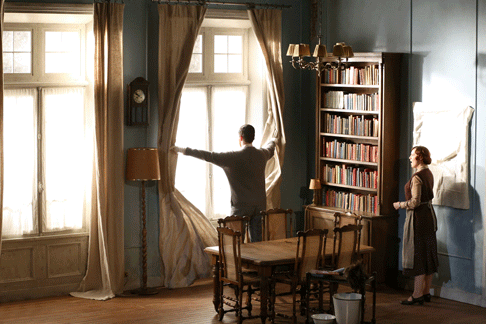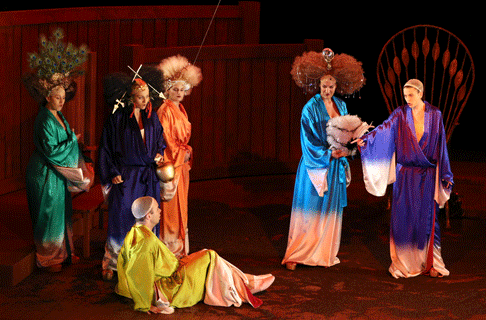In a festival dominated by Elektra directed by Patrice CherÈau, Don Giovanni directed by Dimitri Tcherniakov and Rigoletto directed by Robert Carson gratefully a place was found for a new opera. It was a commission by the Aix Festival through its AcadÈmie EuropÈen de Musique to young (34 years old) Portuguese composer Vasco MendonÁa (by comparison the Mozart of Don Giovanni was 31).
The Aix Festival gave the new opera a substantial production by the esteemed British director Katie Mitchell who last summer imagined a brilliant production of British composer George Benjamin’s Written on Skin for Aix (since seen at the Nederlandse Oper and at Covent Garden). Sig. MendonÁa is in fact a student of George Benjamin who was a student of Britten and Messiaen.
The libretto was contrived by British dramaturge Sam (short for Samantha) Holcroft on a novella by Argentine novelist Julio Cort·zar. Cort·zar emigrated from Argentina to France in 1951 when he was 36 years old. His muses were surrealism, improvisation and stream-of-consciousness. He translated Edgar Allen Poe into Spanish.
You get the idea — traditional genres and dramatic attitudes are out the window though Aristotelian unities were zealously respected. A brother and sister clean then eat and read in a room of an old house. Mysterious noises frighten them, so they transfer the same activities to another room where the same thing occurs. They take these activities onto the front doorstep where the sister realizes she must use a bathroom. They leave the house to embark on new lives.
The libretto in this production did no more than provide composer MendonÁa with a structure on which to expound infinite combinations of tones, colors and rhythms that sometimes directly applied to the story telling, but mostly just percolated along as what seemed to be notated improvisation, or rather invention.
 Scene from The House Taken Over [Photo by Patrick Berger]
Scene from The House Taken Over [Photo by Patrick Berger]
The Asko Schˆnberg Ensemble from the Netherlands was here comprised of two violins, two violas, one cello, one bass, one flute, two clarinets, two trumpets, one trombone plus a myriad of percussion choices presided over by one virtuoso player (Joey Marijs). Etienne Stiebens was the production’s chef d’orchestra. One musical delight followed another in an astonishing array of variation elaborated by these instruments.
Fortunately the grandstand seating at the outdoor Domaine du Grand St. Jean gave us full view into the pit where the evening’s excitement took place. Plenty of it. Cerise sur le g‚teau: the trumpeters at the finale abandoned their horns in favor of Melodicas (plastic keyboard harmonicas).
Director Katie Mitchell with her scenographer, British theater designer Alex Eales, shied away from the surrealism of the novella opting to evoke a commentary on the insignificant and suffocating, narrow lives of the English petite bourgeoisie. The production did not take us into the attractive sonic world of Sig. MendonÁa’s music nor into the subtle philosophic atmospheres felt by an Argentine intellectual based in mid twentieth century Paris.
The Aix Festival provided two quite able, young British singers, mezzo soprano Kitty Whately and baritone Oliver Dunn, both done up to try to look dull middle-aged. These fine young artists managed the undistinguished narrative style delivery of text with crystal clear English diction, and veered into the opera’s very occasional ariosos with vocal gusto. It is not an opera about voices.
This talented young composer may yet find his operatic way, after all Richard Strauss was 41 before he hit his operatic stride with the Salome libretto by Von Hofmannsthal. Perhaps Mr. MendonÁa should look beyond British theatrical forces.
Elena aka The Abduction of Helen by Cavalli is of course not about Helen of Troy even though it says it is. It is really about racy attitudes towards sex and marriage in 17th century Venice. All of Venice had been excommunicated when Cavalli was four years old, not for its free and easy morality but rather because this rich city had the confidence to ignore playing by rules imposed by others. Elena, the thirty-second of his forty one or so operas, is also about playing harmlessly outside the rules, those of restraint or civilized conduct in particular.
The operas that have made Cavalli famous these days — L’Ormindo, La Calisto and L’Erismena — are all earlier in the Cavalli oeuvre and exemplify the easy charm of stories about deities falling in and out of love with doses of sincerity here and there. Cavalli turned out Elena at age 57 when he was at the height of his fame (the next year Louis XIV lured him to Paris with a special, high tech theater built just for his Ercole Amante). At this point it was easy, too easy for Cavalli to make an opera. Elena seems far too contrived, and perhaps it is an opera best forgotten.
 Scene from Elena [Photo by Patrick Berger]
Scene from Elena [Photo by Patrick Berger]
Like all Cavalli operas Elena has a big cast of characters, all with lots to do. Casting is sophisticated at the Aix Festival, and with rare exception true to character and voice and with rare exception indifferent to fame. At the same time the Aix Festival knows the virtues and financial rewards of encouraging young artists. Thus the large cast was comprised of talented young singers all of whom were well nurtured indeed by the opera world’s elaborate and extensive apprentice system.
There was therefore a uniformity of relatively high level talent and technical ability. This was the limitation of the cast. Cavalli’s characters were created by generic, well trained young singers rather than by mature or finished artists with specific traits that qualify them to bring artistic life to human character. Those few with hints of greater artistry fell victim to a generic apprentice atmosphere of promise rather than accomplishment.
The production was in the Festival’s tiny ThÈ‚tre du Jeu de Paume, a relic in the Italian horseshoe style that is perfect for Baroque opera. It was staged by Jean-Yves Ruf, a young French theater pedagogue with acting credentials as well, in a stage space that resembled a bull ring in the first half and a macramÈ fantasy in the second. The scenery and costumes were fashionable, generic theatre designs that probed “look” rather than depth. It was a long, very long evening.
Ten members of Ambronay’s (a town between Lyon and Geneva) early music ensemble Capella Mediterranea plucked, sawed and tooted in finest, informed period style, led by its founder of Argentine origin and Swiss training, Leonardo Garci· AlarcÛn.
With the cost of tickets at one half that for major productions at the Aix Festival, productions like Elena and The House Over Taken open the festival to a larger public, those unable or unwilling to bear the $300 plus cost of a ticket for Don Giovanni or Elektra.
Michael Milenski
Casts and Production:
The House Taken Over
Brother: Oliver Dunn; Sister: Kitty Whately. Asko | Schˆnberg Ensemble conducted by Etienne Siebens. Mise en scËne: Katie Mitchell; Scenery: Alex Eales; Lighting: James Farncombe. Domaine du Grand St. Jean, July 11, 2013.
Elena
Elena/Venere: Emˆke Barath; Menelao: Valer Barna-Sabadus; Teseo: Fernando Guimaraes; Ippolita/Pallade: Solenn’ Lavanant Linke; Peritoo: Rodrigo Ferreira; Iro: Emiliano Gonzalez Toro; Menesto/La Pace: Anna Reinhold; Tindaro/Nettuno: Scott Conner; Erginda/Giunone/Castore: Mariana Flores; Eurite/La Verita: Majdouline Zerari; Diomede/Creonte: Brendan Tuohy; Euripilo/La Discordia/Polluce: Christopher Lowrey; Antiloco: Job TomÈ. Cappella Mediterranea conducted by Leonardo GarcÌa AlarcÛn. Mise en scËne: Jean-Yves Ruf; Scenery: Laure Pichat; Costumes : Claudia Jenatsch; Lighting: Christian Dubet. ThÈ‚tre du Jeu de Paume, July 17, 2013.
image=http://www.operatoday.com/ELENA-repetition-5016.gif
image_description=Scene from Elena [Photo by Pascal Victor]
product=yes
product_title=Elena and The House Taken Over at the Aix Festival
product_by=A review by Michael Milenski
product_id=Above: Scene from Elena [Photo by Pascal Victor]